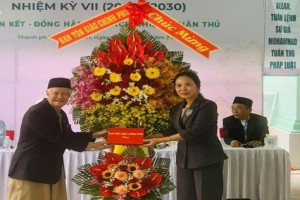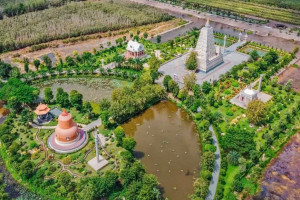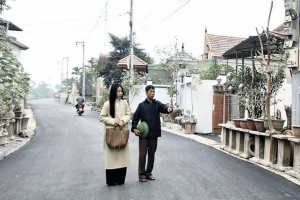
Historical Development
Tu An Hieu Nghia faith was founded on May of 1867 by Master Ngô Lợi in a place now belonging to Vietnam’s Southern An Giang province. Mr. Ngô Lợi, an patristic intellectual, was born in Ben Tre province and joint a movement against French colonialism in South Vietnam’s Tien Giang province, and later he moved to An Giang province for hiding.
Initially the faith was referred by the founding master as “worship of ancestors”, and later renamed by followers as “Way of Four Debts of Gratitude (Dao Tứ Ân Hiếu Nghĩa as in Vietnamese).
Embracing the guideline “Improve Oneself - Study Buddhism” and using simple and poetic forms of religious texts that make religious teachings easy for peasants to understand and learn by heart, Tu An Hieu Nghia Faith rapidly attracted a large number of people in largely agricultural areas of South Vietnam. During his life time, Master Ngô Lợi attached the religious propagation with the agricultural development in localities.
In a later stage of development, the faith founder established and built temples for carrying out religious rituals and collective practices, as well as conducted missionary activities in neighboring provinces. In 1870, Master Ngô Lợi was officially honored as Founding Master of Tu An Hieu Nghia Faith.
When Master Ngô Lợi passed away, his close disciples continued to practice and preach the religion in other provinces of Kien Giang, Ben Tre, Dong Thap, Tien Giang, Can Tho, Ba Ria – Vung Tau…
By 1975, followers of Tu A Hieu Nghia numbered over one hundred thousand people, most of whom were peasants from the Mekong delta region in South Vietnam.
Implementing the Ordinance on Belief and Religion 2004, Chairman of An Giang provincial People’s Committee granted the recognition of religious organization to Tu An Hieu Nghia faith on June 16, 2010.
Currently, local statistics on Tu An Hieu Nghai faith indicate a number of sixty thousand followers living in southern provinces An Giang, Ba Ria – Vung Tau, Can Tho, Dong Thap, Kien Giang, Tien Giang, Tra Vinh, Vinh Long …
Charactersitics of Tu An Hieu Nghia Faith
Tu An Hieu Nghia Faith was developed during a process of the migration and agricultural development in the Southern delta, known as the rice basket of Vietnam. Its followers have been mainly Southern peasants.
Like Buu Son Ky Huong faith - another Vietnamese indigenous religion founded earlier - and later Hoa Hao Buddhism, Tu An Hieu Nghia faith takes the guiding principle "Improve Oneself - Study Buddhism" as the religious motto. Practices for “Improve Oneself” show a harmonious influence of Buddhism, Confucianism, Taoism and indigenous beliefs that have taken roots in Vietnam for a long time.
In particular, Master Ngô Lợi instructs followers to, first of all, do his best to comply with the Four Debts Of Gratitude: (1) the debt of gratitude to the parents and ancestors; (2) the debt of gratitude to the home country; (3) the debt of gratitude to the Buddhist Three Treasures; and (4) the debt of gratitude to all fellow countrymen and mankind.
First, with regard to the debt owed to ancestors and parents, the father and mother are those endured great sufferings and hardships in the process of pregnancy, giving birth, nurturing and bringing up their children. The great ocean is incomparable to the love your mother has given you; the vast sky and cloud is paltry as compared to the life burden your father has shouldered. So, when you come of age and take faith in Buddhism, you must first of all bear in mind these debts you owe to your father and mother and think of paying the debt you owe to your parents, as well as your grand parents and ancestors who also deserve the repay of gratitude for the same dedication and contribution.
Second is the debt of gratitude to be paid to the home country. The home country embraced you just when you were born and brought all things you enjoy and need for your maturity. To show the thankfulness to the home country, one should stay ready to serve what the fatherland requires, defend the mother country against any foreign invasion, and make the country prosperous and strong.
Third is the debt of gratitude to be paid to the Buddha, Buddhist teachings and Buddhist Sangha – the three Treasures of Buddhism. The Buddha, his teachings and his disciples’ established church are all to serve the purpose of alleviating human sufferings and attaining enlightenment. Thus, to repay the debt of gratitude to the Buddhist Three Treasures, one should observe, practice and propagate Buddhist teachings, for salvation and enlightenment of oneself as well as his/her fellow human and living beings.
Fourth is the debt of gratitude to be paid to fellow countrymen and mankind. As indicated by all religion, we are all from the one and the same original source. Additionally, Buddhist teachings reveal that, at one time or another in the past, we relate to each other as relatives, thus, in the course of all the many lifetimes and existences you have lived through, you have come to owe a debt of gratitude to fellow human beings, irrespective of color, religious or racial differences. And since this is so, you should live in brotherhood with others, especially fellow countrymen who share same racial blood, cultural and historical values.
Tu An Hieu Nghia faith emphasis the respect and practice of the familial piety, and does not issue strict rules. All dignitaries and followers of the church can still get married and stay at homes with the family.
In the religious personnel and organizational system, under the faith founder there are a group of great disciples divided in two functioning roles: upholding the founder’s principle teachings and taking care of the followers. Tu An Hieu Nghia church established 24 branches for taking care of the followers, each branch led by a nominated head and attached to one religious establishment called Tam Buu House (Three-Treasure house).
Initially, Tu An Hieu Nghia did not establish any religious administrative structure. In a later period of development, the head of 24 branches altogether formed a body called the faith council, which is considered as the highest administration of Tu An Hieu Nghia faith, and has its head office placed in Tam Buu House in Tri Ton district, An Giang province. The only other lower administrative level is established in each religious branch. Assistants to the branch head include three categories of religious deacons for three separate religious roles: assistants for information and communication, assistants for initiating religious ceremonies and rituals, and assistants for preparing ceremonies and rituals.
Followers of Tu An Hieu Nghia worship and practice religious activities at home and at the church’s facilities including shines, temples and Tam Buu houses. Unlike Buddhist pagoda, temples of Tu An Hieu Nghia faith are not the residential place for any dignitaries. They are only venues for religious worshipping and collective religious practices by dignitaries and followers. In addition, these temples are also used as clinics for medial treatments provided for followers.
For a period of nearly one and a half centuries since its founding, the development of Tu An Hieu Nghia faith has contributed to meet spiritual demands of a segment of Vietnam’s Southern peasants.
Bui Quang Nhuong




